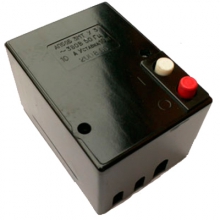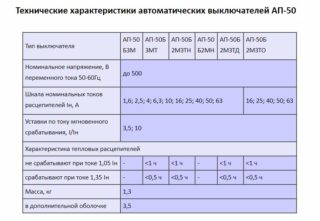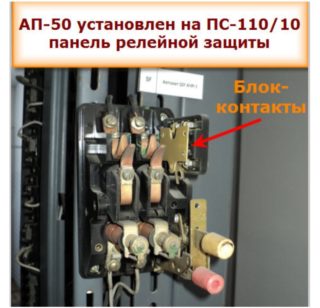Automatic circuit breaker AP-50 is used to protect electric motors and other electrical installations from overload and short circuit incidents. They are also used to start and stop motors and electrical circuits.
The device of the AP-50 machine

The products in this series are available in two and three poles. Devices from the first group are designed for constant electric current with a nominal voltage of up to 220 V and alternating current - up to 500 V (50-60 Hz). Three-pole models work with AC only (parameters are the same as for two-pole devices). The electrical filling of the machine is placed in a plastic case, which includes a removable front panel, bottom and main part.
The switch has 4 technological units:
- a control mechanism based on a free trip, with instantly triggered on and off buttons;
- arc extinguishing chambers (located at the bottom of the device);
- releasers of extra-high currents - thermal (covered on top with a protective plate made of textolite) and electromagnetic;
- contact system, including stationary and movable elements.
The magnetic release is responsible for an ultra-fast misfire in the area of short-circuit currents, and the thermal release is switched on in the overload zone, while the higher the current, the shorter the response time. The factory calibration of the releases is carried out at an air temperature of 35 ° C. The device also has inputs and outputs for cable management. It is installed on a vertical or horizontal base with a pair of screws. There is enough space inside the enclosure to allow for additional components such as an extra-low voltage release (although there are factory-fitted models available) or block contacts. A lever is mounted under the buttons of the control mechanism, which regulates the susceptibility of the releases.
Among the AP-50 models, there are those not equipped with auxiliary contacts at all, having one or two contacts. In devices not equipped with such a component, you can put it yourself.
Specifications
At room temperature (15-25 ° C), the characteristics of the thermal release are as follows:
- with a current of 1.05 In during an hour of operation does not occur;
- contacts open in half an hour at a current of 1.35 In;
- if a load of 6 In is sent to one of the poles, the overload release will be active for 2-15 seconds;
- after disengaging, you can turn on the device the next time after 2 minutes (during this time, the mechanism cools down).
The machines are sharpened for a limited number of on and off switches (50,000).The maximum switching capacity for currents up to currents up to 10 A is 50,000, for 16-25 A - 25,000, for large values - 20,000. The limiting current at which the device is turned on is 10 A.
From time to time, you need to clean the device from dust and dirt, check the position of the contacts (there should be no bias). It is necessary to regularly dedust the area around the device. Dust is highly conductive and can easily damage the circuit breaker.
Current limiting class (cutoff speed)

The technical documentation supplied with the device does not provide data on the cutoff response speed. But this parameter can be determined during practical tests in commissioning organizations. A properly functioning switch generates a cutoff in 0.01-0.015 s. If the time exceeds 0.2 s, the device is considered faulty. Given the significant stroke of the core, the class of current limitation for this group of devices is in the region of unity. In situations where this parameter plays a significant role, it is better to purchase a machine of another brand with high speed.
Tripping characteristic
The time-current characteristics of the AP-50 series of devices vary depending on the indicator of the current strength. For In in 1,6,2,5 and 4 A, the response time at small numbers of the multiplicity of current (2-4) is shorter than for large values of In, and at large overloads, on the contrary, it is slightly longer. Thermal releases at any current values are triggered by an overload of 1.5-3 times, and the reaction time varies within 70-300 s. Magnetic releases for 3.5 In are closed more slowly (up to 60 s), and for 10 In - they are activated at eight times or more overloads within a single number of seconds.
Operating principle
Manufacturers of automatic switches AP-50
Automatic machines are made at Russian and Ukrainian enterprises. Of the first, the largest manufacturers are Kursk Electrical Apparatus Plant (its products are labeled as AP50B) and Elektrokontaktor from Chelyabinsk, which introduces some modifications to the design: square buttons instead of round ones, contacts for connecting to the network are located on the surface of the casing. In Ukraine, the circuit breakers are manufactured by the UPP UTOS, located in the Zhytomyr region in the city of Korosten.
Testing machine AP50
This procedure includes checking the functioning of the two main releases. The process uses a current with different overload rates.
Checking the thermal release AP50

For example, RETOM-21 can be used as a test device. It is connected to the outermost poles of the circuit breaker after the series connection of the poles. Testing is carried out with three types of current:
- 1.05 * In or 1.1 * In (where In is the nominal value) - when such a current is applied, the device should not turn off for an hour;
- 1.35 * In - current at which tripping should occur within half an hour;
- 6 * In - when such an overload is applied, disconnection occurs within 2-15 seconds.
The procedure allows you to check the serviceability of the machine when responding to various degrees of overload.
Checking the AP50 electromagnetic release
This release is triggered by a tenfold overload (10 * In, i.e. 500 A). Switching off should occur in 0.1-0.2 s, with a longer response, the device is considered defective.
AP-50 series devices are well suited for protecting networks from overload and preventing short circuit incidents. However, in case of great importance of the class of current limitation, it is better to choose a faster-acting machine. It is also important to comply with the operating conditions - do not allow excessive air humidity and water ingress on the case or inside the switch










